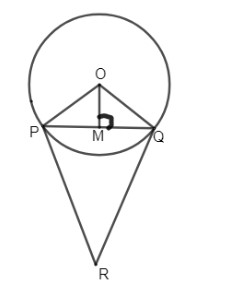
If \[\angle RPQ={{45}^{\circ }}\], find \[\angle PRQ\]
A. \[{{60}^{\circ }}\]
B. \[{{90}^{\circ }}\]
C. \[{{120}^{\circ }}\]
D. \[{{150}^{\circ }}\]


Answer
605.7k+ views
Hint: Consider, \[\vartriangle PQR\], use the properties of the isosceles triangle and find the \[\angle PRQ\]. PR and QR are tangents from a point R meeting the circle at P and Q.
“Complete step-by-step answer:”
Given a figure, with a circle whose center is O. From the figure we can say that PR and QR are tangents to the circle from a point R. Three tangents from an external point to the circle are equal.
\[\therefore PR=QR\]
Now let us consider the isosceles triangle, \[\vartriangle PRQ\].
As it is an isosceles triangle, we know that two sides of an isosceles triangle are equal.
In \[\vartriangle PRQ\], we know that PR = QR.
Thus the angle RPQ is equal to angle PQR, because they are the base angles of an isosceles triangle.
We have been given, \[\angle RPQ={{45}^{\circ }}\].
\[\angle RPQ=\angle PQR={{45}^{\circ }}\].
The angle sum property of triangle, states that the sum of interior angles of a triangle is \[{{180}^{\circ }}\].
Hence, in the isosceles triangle PRQ, the sum of all the interior angles is \[{{180}^{\circ }}\].
\[\therefore \angle RPQ+\angle PQR+\angle PRQ={{180}^{\circ }}\]
We need to find the \[\angle PRQ\].
We already found out that, \[\angle RPQ=\angle PQR={{45}^{\circ }}\].
Thus substituting these values in the sum of triangle,
\[\begin{align}
& \angle RPQ+\angle PQR+\angle PRQ={{180}^{\circ }} \\
& {{45}^{\circ }}+{{45}^{\circ }}+\angle PRQ={{180}^{\circ }} \\
& \angle PRQ=180-45-45=180-90 \\
& \angle PRQ={{90}^{\circ }} \\
\end{align}\]
Hence, we got \[\angle PRQ={{90}^{\circ }}\], which makes \[\vartriangle PRQ\] right angled at R.
\[\therefore \]Option (b) is the correct answer.
Note: By seeing the figure, you may try to take \[\vartriangle POQ\] instead of \[\vartriangle PRQ\], understand the question that we only need to find \[\angle PRQ\]. So we should take, \[\vartriangle PRQ\]. As tangents from the external point of the circle are equal, the sides of the triangle are same, thus angles are same and we can get \[\angle PRQ\]easily.
“Complete step-by-step answer:”
Given a figure, with a circle whose center is O. From the figure we can say that PR and QR are tangents to the circle from a point R. Three tangents from an external point to the circle are equal.
\[\therefore PR=QR\]
Now let us consider the isosceles triangle, \[\vartriangle PRQ\].
As it is an isosceles triangle, we know that two sides of an isosceles triangle are equal.
In \[\vartriangle PRQ\], we know that PR = QR.
Thus the angle RPQ is equal to angle PQR, because they are the base angles of an isosceles triangle.
We have been given, \[\angle RPQ={{45}^{\circ }}\].
\[\angle RPQ=\angle PQR={{45}^{\circ }}\].
The angle sum property of triangle, states that the sum of interior angles of a triangle is \[{{180}^{\circ }}\].
Hence, in the isosceles triangle PRQ, the sum of all the interior angles is \[{{180}^{\circ }}\].
\[\therefore \angle RPQ+\angle PQR+\angle PRQ={{180}^{\circ }}\]
We need to find the \[\angle PRQ\].
We already found out that, \[\angle RPQ=\angle PQR={{45}^{\circ }}\].
Thus substituting these values in the sum of triangle,
\[\begin{align}
& \angle RPQ+\angle PQR+\angle PRQ={{180}^{\circ }} \\
& {{45}^{\circ }}+{{45}^{\circ }}+\angle PRQ={{180}^{\circ }} \\
& \angle PRQ=180-45-45=180-90 \\
& \angle PRQ={{90}^{\circ }} \\
\end{align}\]
Hence, we got \[\angle PRQ={{90}^{\circ }}\], which makes \[\vartriangle PRQ\] right angled at R.
\[\therefore \]Option (b) is the correct answer.
Note: By seeing the figure, you may try to take \[\vartriangle POQ\] instead of \[\vartriangle PRQ\], understand the question that we only need to find \[\angle PRQ\]. So we should take, \[\vartriangle PRQ\]. As tangents from the external point of the circle are equal, the sides of the triangle are same, thus angles are same and we can get \[\angle PRQ\]easily.
Recently Updated Pages
Master Class 11 Economics: Engaging Questions & Answers for Success

Master Class 11 English: Engaging Questions & Answers for Success

Master Class 11 Social Science: Engaging Questions & Answers for Success

Master Class 11 Biology: Engaging Questions & Answers for Success

Class 11 Question and Answer - Your Ultimate Solutions Guide

Master Class 11 Business Studies: Engaging Questions & Answers for Success

Trending doubts
What is meant by exothermic and endothermic reactions class 11 chemistry CBSE

What are Quantum numbers Explain the quantum number class 11 chemistry CBSE

What is periodicity class 11 chemistry CBSE

Explain zero factorial class 11 maths CBSE

What is a periderm How does periderm formation take class 11 biology CBSE

Mention the basic forces in nature class 11 physics CBSE




